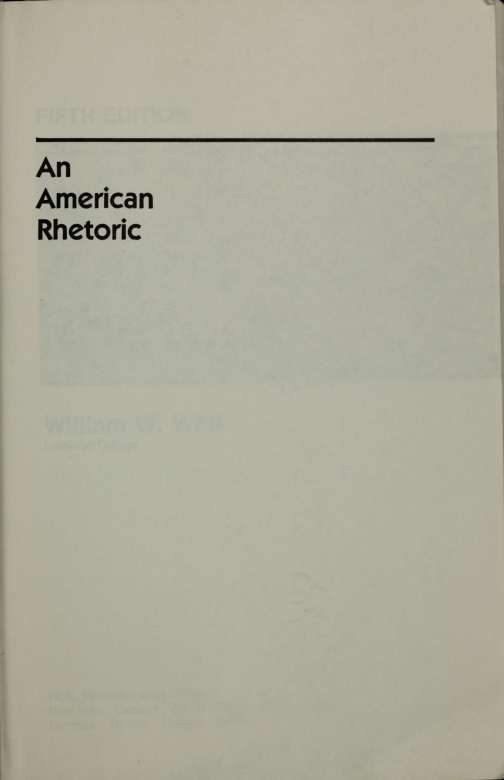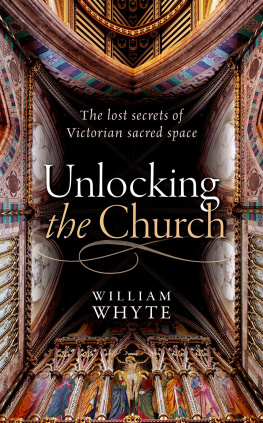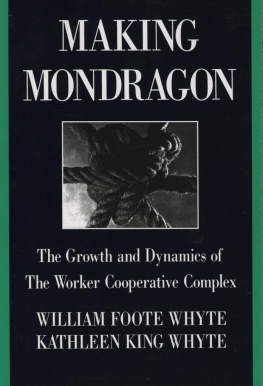William Whyte Watt - An American Rhetoric
Here you can read online William Whyte Watt - An American Rhetoric full text of the book (entire story) in english for free. Download pdf and epub, get meaning, cover and reviews about this ebook. year: 1980, publisher: Harcourt School, genre: Art / Prose. Description of the work, (preface) as well as reviews are available. Best literature library LitArk.com created for fans of good reading and offers a wide selection of genres:
Romance novel
Science fiction
Adventure
Detective
Science
History
Home and family
Prose
Art
Politics
Computer
Non-fiction
Religion
Business
Children
Humor
Choose a favorite category and find really read worthwhile books. Enjoy immersion in the world of imagination, feel the emotions of the characters or learn something new for yourself, make an fascinating discovery.
- Book:An American Rhetoric
- Author:
- Publisher:Harcourt School
- Genre:
- Year:1980
- Rating:4 / 5
- Favourites:Add to favourites
- Your mark:
- 80
- 1
- 2
- 3
- 4
- 5
An American Rhetoric: summary, description and annotation
We offer to read an annotation, description, summary or preface (depends on what the author of the book "An American Rhetoric" wrote himself). If you haven't found the necessary information about the book — write in the comments, we will try to find it.
An American Rhetoric — read online for free the complete book (whole text) full work
Below is the text of the book, divided by pages. System saving the place of the last page read, allows you to conveniently read the book "An American Rhetoric" online for free, without having to search again every time where you left off. Put a bookmark, and you can go to the page where you finished reading at any time.
Font size:
Interval:
Bookmark:

This book made available by the Internet Archive.





c. s. lewis. Excerpt from The World's Last Night. Published by Harcourt Brace Jovanovich. Reprinted by permission of Curtis Brown, Ltd. Copyright 1960 by C. S. Lewis. Also by permission of Wm. Collins Sons & Co., Ltd.
lewis mumford. Excerpt from "The American Way of Death." Copyright 1966 by Lewis Mumford. Published in The New York Review of Books. Reprinted by permission of the author.
lewis Thomas. Excerpts from Lives of a Cell. Copyright 1974 by Lewis Thomas. All rights reserved. Reprinted by permission of Viking Penguin, Inc.
james thurber. Excerpts from My Life and Hard Times. Published by Harper & Row. Copyright 1933,1961 James Thurber. Originally printed inThe New Yorker. Reprinted by permission of Mrs. James Thurber. Also by permission of UK publishers Hamish Hamilton, London. Collection copyright James Thurber.
E. B. white. Excerpts from One Man's Meat. From "First World War"; copyright 1939 by E. B. White. From "Once More to the Lake"; copyright 1941 by E. B. White. Reprinted by permission of Harper & Row, Publishers, Inc.
e. b. white. Excerpts from The Second Tree from the Corner. Reprinted by permission of the author.
Virginia woolf. Excerpt from The Common Reader: Second Series. Copyright 1925 by Harcourt Brace Jovanovich, Inc. Excerpts from A Writer's Diary. Copyright 1953, 1954 by Leonard Woolf. Reprinted by permission of Harcourt Brace Jovanovich, Inc. Also by permission of the Author's Literary Estate and The Hogarth Press.
Preface
For this new edition I have made the following changes, most of them in direct response to instructors and students who have used the book in classroom and study:
1. I have added numerous new illustrations and exercises.
2. I have clarified and, in some places, simplified the language to make it accessible to a wider range of readers.
3. I have made regular changes in the point of view to address the undergraduate reader directly as a presence called "you" and avoid, wherever possible, references to that absent third person called "the student."
4. Without resorting to simplistic streamlining, I have shortened some chapters to make the discussion less discursive and the key points more clear.
5. In Chapters 4, 5, 6, 10, and 11where it seemed most feasibleI have distributed the exercises so that each follows immediately after the discussion to which it applies. This provides periodic pauses for immediate testing instead of sending the reader on a search at the end of the chapter.
6. For the specimen research paper I have included a modernized version of "Martians and Mass Hysteria," which some of my older readers may remember from the first two editions. Several friendly critics suggested that it would be hard to find a suitable subject of more general interest to undergraduates in this age of star wars.
PREFACE
7. I have significantly expanded the book in the following places: Chapter 2to include more emphasis on pre-writing. Chapter 9to enlarge the number of sample entries for footnotes and
bibliography, all in strict accordance with the MLA Handbook. "A Glossary of Grammatical and Rhetorical Terms." This is a completely new supplement, included on the assumption that readers, especially the many students who come to college with little previous knowledge of grammar and rhetoric, will welcome a handy alphabetical guide to the standard nomenclature used throughout the text. This Glossary, taken together with the "Glossary of Usage" and an unusually extensive general index, should greatly increase the value of the book as a ready reference and encourage students to consult it regularly without benefit of classroom assignments.
Finally, the book has been completely redesigned and reset with larger, clearer type to make it much easier to read, study, and teach than the fourth edition.
Despite all these changes, I have not abandoned my convictions apparently shared by thousands of other usersabout what a college composition text should be: readable as well as teachable; serious but livelynever solemn or stuffy; accurate but not pedantic; complete, without trivial details; generously supplied with a variety of examples of good and bad writing, both professional and amateur; equipped with a mixed bag of practical exercises; full of useful advice based on the living language, not cluttered with awful warnings from dead rulebooks; designed to develop lively, adaptable, versatile writers, not limited specialists in "the college essay" or "the five-paragraph expository theme."
With the encouragement of my critics I have kept the basic organization of the fourth edition. "A Guide to Good Writing" (the "Rhetoric") is followed by "A Guide to Correctness" (the "Handbook") and the two Glossaries. The order of the chapters, though far from arbitrary, is not compulsory. The instructor, or whoever prescribes the local ground rules, is encouraged to take them up in whatever sequence best fits the course requirements and student needs. Whether the instructor begins with Grammar, Punctuation, or Spelling, or uses them merely for reference; or assigns Words before Sentences and Paragraphs; or postpones the introductory chapter till a final review; or entirely finesses the formal study of the Dictionary or the Research Paper; or regularly prescribes the Exercises or studiously ignores themthe book is flexible enough to allow such freedom.
I have prepared an Instructor's Manual that contains a detailed analysis of the exercises. It may be obtained through a local Holt representative or by writing to English Editor, College Department, Holt, Rinehart and Winston, 383 Madison Avenue, New York, N.Y. 10017.
My gratitude for extensive quotations is expressed in the proper place and form. I hereby acknowledge all debts to other sources, including the
PREFACE
dictionaries listed in Chapter 5, the rhetorics and handbooks by my competitors, and the colleagues and students at Lafayette who have taught me more than I ever taught them. I am grateful to the following critics around the country whose useful comments first set me on the road to revision or helped to improve the final manuscript; Joanne Cockelreas, East Texas State University; Loren C. Gruber, Simpson College; Jule Kaufman, University of Cincinnati; Clemens H. Neuhaus, San Bernardino Valley College; Jim Raymond, University of Alabama; Liz Rosenberg, State University of New York at Binghamton; Robert S. Rudolph, University of Toledo; Joseph P. Sperry, Capital University; Joyce S. Steward, University of Wisconsin; Richard Tuerk, East Texas State University; William Wiley, Riverside City College.
More particularly, I want to thank two friends at Holt, Rinehart and Winston, Kenney Withers, for hospitality and encouragement, and Pamela Forcey, whose conscientious efficiency as an editor is matched only by her good judgment and cheerful patience; Richard S. Beal of Boston University, whose good-natured criticism has been consistently sensitive and sensible; Marilyn Kastenhuber, a superior departmental secretary, who interrupted her summer vacation to type the Instructor's Manual; and my favorite collaborator, Sidney Watt, who, as always, pulled a strong and steady oar in the galleys.
Font size:
Interval:
Bookmark:
Similar books «An American Rhetoric»
Look at similar books to An American Rhetoric. We have selected literature similar in name and meaning in the hope of providing readers with more options to find new, interesting, not yet read works.
Discussion, reviews of the book An American Rhetoric and just readers' own opinions. Leave your comments, write what you think about the work, its meaning or the main characters. Specify what exactly you liked and what you didn't like, and why you think so.











